Critical Appraisal of Professional Practice in Nursing Report
VerifiedAdded on 2023/01/18
|5
|1163
|84
Report
AI Summary
This report provides a critical appraisal of professional practice in nursing, addressing ethical dilemmas through case scenarios. The analysis centers on the ICN code of ethics, specifically focusing on nurses and practice, nurses and people, and nurses and the profession. The report examines the importance of maintaining professional boundaries, managing therapeutic relationships, and prioritizing patient interests. It discusses scenarios involving patient interactions, potential boundary violations, and the nurse's role in maintaining confidentiality and upholding ethical standards. The report emphasizes the nurse's responsibility to provide standardized care, advocate for patient well-being, and navigate complex ethical situations while adhering to professional guidelines. The report concludes with a list of relevant references supporting the analysis.
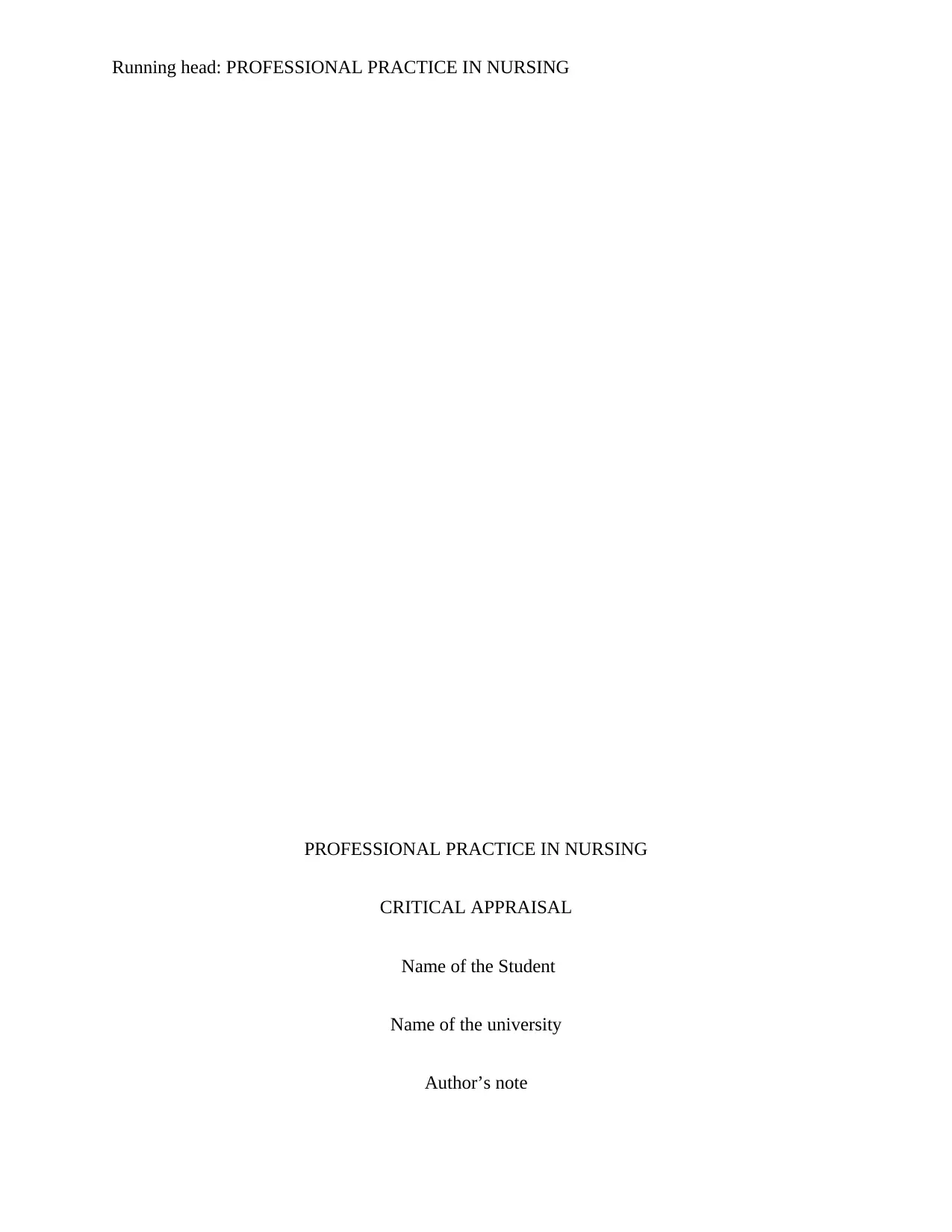
Running head: PROFESSIONAL PRACTICE IN NURSING
PROFESSIONAL PRACTICE IN NURSING
CRITICAL APPRAISAL
Name of the Student
Name of the university
Author’s note
PROFESSIONAL PRACTICE IN NURSING
CRITICAL APPRAISAL
Name of the Student
Name of the university
Author’s note
Paraphrase This Document
Need a fresh take? Get an instant paraphrase of this document with our AI Paraphraser
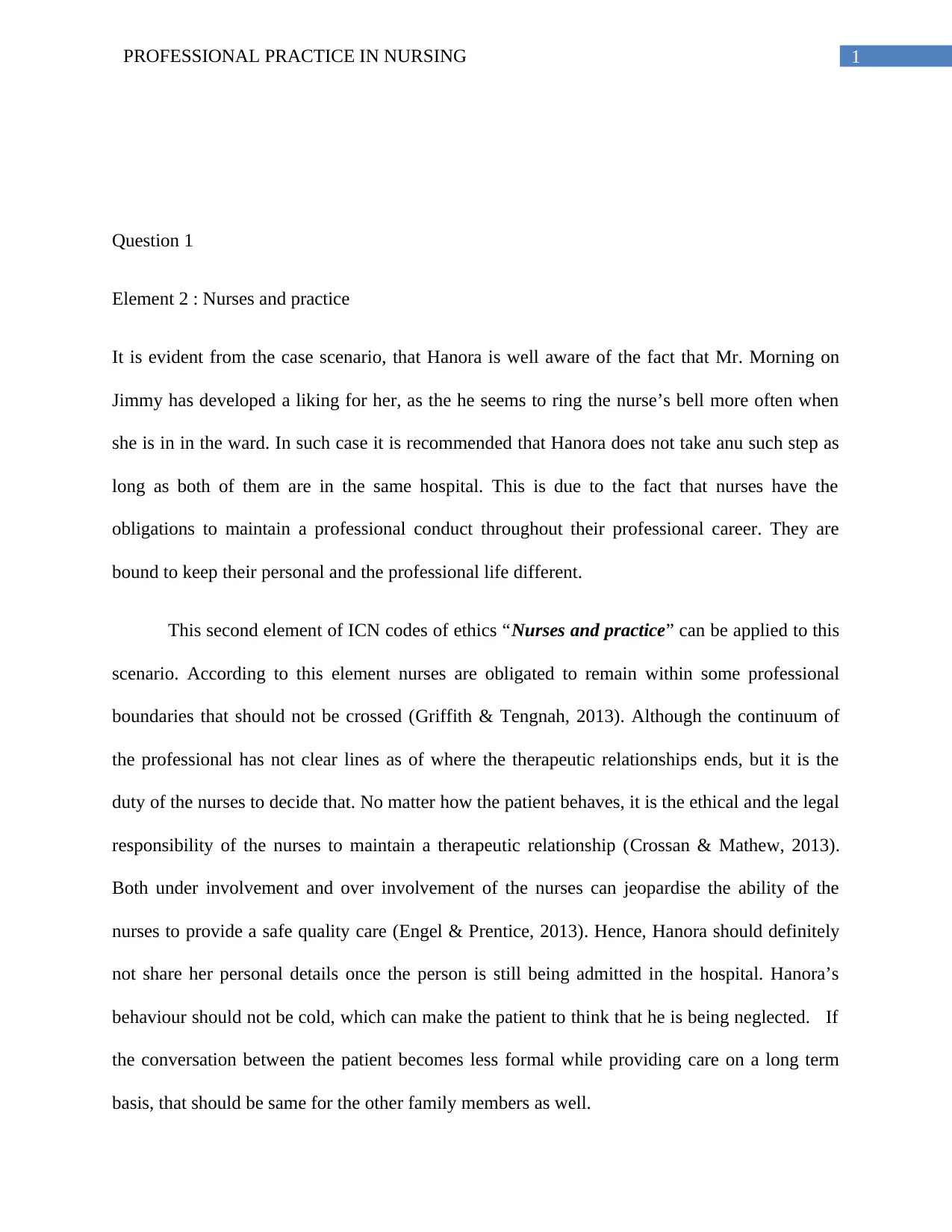
1PROFESSIONAL PRACTICE IN NURSING
Question 1
Element 2 : Nurses and practice
It is evident from the case scenario, that Hanora is well aware of the fact that Mr. Morning on
Jimmy has developed a liking for her, as the he seems to ring the nurse’s bell more often when
she is in in the ward. In such case it is recommended that Hanora does not take anu such step as
long as both of them are in the same hospital. This is due to the fact that nurses have the
obligations to maintain a professional conduct throughout their professional career. They are
bound to keep their personal and the professional life different.
This second element of ICN codes of ethics “Nurses and practice” can be applied to this
scenario. According to this element nurses are obligated to remain within some professional
boundaries that should not be crossed (Griffith & Tengnah, 2013). Although the continuum of
the professional has not clear lines as of where the therapeutic relationships ends, but it is the
duty of the nurses to decide that. No matter how the patient behaves, it is the ethical and the legal
responsibility of the nurses to maintain a therapeutic relationship (Crossan & Mathew, 2013).
Both under involvement and over involvement of the nurses can jeopardise the ability of the
nurses to provide a safe quality care (Engel & Prentice, 2013). Hence, Hanora should definitely
not share her personal details once the person is still being admitted in the hospital. Hanora’s
behaviour should not be cold, which can make the patient to think that he is being neglected. If
the conversation between the patient becomes less formal while providing care on a long term
basis, that should be same for the other family members as well.
Question 1
Element 2 : Nurses and practice
It is evident from the case scenario, that Hanora is well aware of the fact that Mr. Morning on
Jimmy has developed a liking for her, as the he seems to ring the nurse’s bell more often when
she is in in the ward. In such case it is recommended that Hanora does not take anu such step as
long as both of them are in the same hospital. This is due to the fact that nurses have the
obligations to maintain a professional conduct throughout their professional career. They are
bound to keep their personal and the professional life different.
This second element of ICN codes of ethics “Nurses and practice” can be applied to this
scenario. According to this element nurses are obligated to remain within some professional
boundaries that should not be crossed (Griffith & Tengnah, 2013). Although the continuum of
the professional has not clear lines as of where the therapeutic relationships ends, but it is the
duty of the nurses to decide that. No matter how the patient behaves, it is the ethical and the legal
responsibility of the nurses to maintain a therapeutic relationship (Crossan & Mathew, 2013).
Both under involvement and over involvement of the nurses can jeopardise the ability of the
nurses to provide a safe quality care (Engel & Prentice, 2013). Hence, Hanora should definitely
not share her personal details once the person is still being admitted in the hospital. Hanora’s
behaviour should not be cold, which can make the patient to think that he is being neglected. If
the conversation between the patient becomes less formal while providing care on a long term
basis, that should be same for the other family members as well.
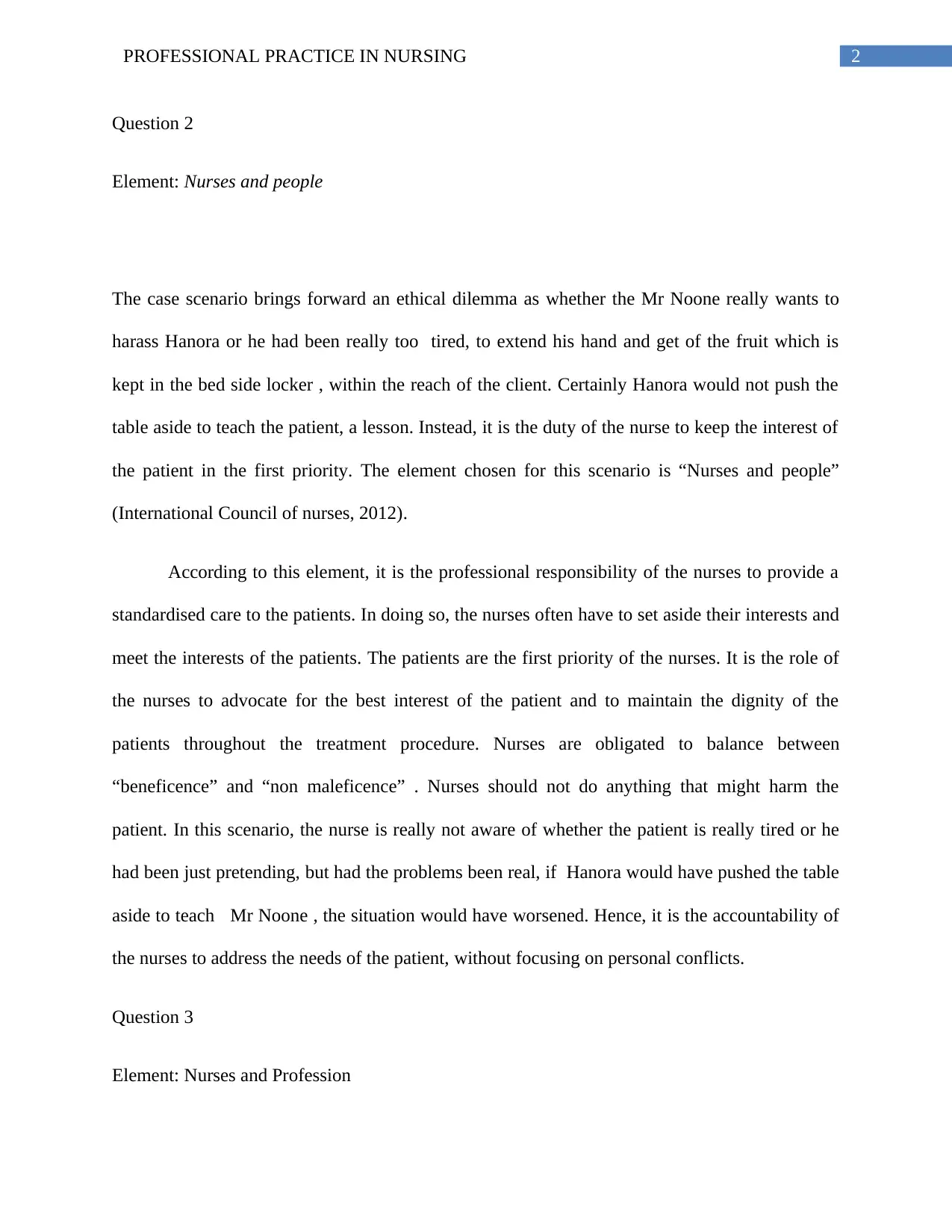
2PROFESSIONAL PRACTICE IN NURSING
Question 2
Element: Nurses and people
The case scenario brings forward an ethical dilemma as whether the Mr Noone really wants to
harass Hanora or he had been really too tired, to extend his hand and get of the fruit which is
kept in the bed side locker , within the reach of the client. Certainly Hanora would not push the
table aside to teach the patient, a lesson. Instead, it is the duty of the nurse to keep the interest of
the patient in the first priority. The element chosen for this scenario is “Nurses and people”
(International Council of nurses, 2012).
According to this element, it is the professional responsibility of the nurses to provide a
standardised care to the patients. In doing so, the nurses often have to set aside their interests and
meet the interests of the patients. The patients are the first priority of the nurses. It is the role of
the nurses to advocate for the best interest of the patient and to maintain the dignity of the
patients throughout the treatment procedure. Nurses are obligated to balance between
“beneficence” and “non maleficence” . Nurses should not do anything that might harm the
patient. In this scenario, the nurse is really not aware of whether the patient is really tired or he
had been just pretending, but had the problems been real, if Hanora would have pushed the table
aside to teach Mr Noone , the situation would have worsened. Hence, it is the accountability of
the nurses to address the needs of the patient, without focusing on personal conflicts.
Question 3
Element: Nurses and Profession
Question 2
Element: Nurses and people
The case scenario brings forward an ethical dilemma as whether the Mr Noone really wants to
harass Hanora or he had been really too tired, to extend his hand and get of the fruit which is
kept in the bed side locker , within the reach of the client. Certainly Hanora would not push the
table aside to teach the patient, a lesson. Instead, it is the duty of the nurse to keep the interest of
the patient in the first priority. The element chosen for this scenario is “Nurses and people”
(International Council of nurses, 2012).
According to this element, it is the professional responsibility of the nurses to provide a
standardised care to the patients. In doing so, the nurses often have to set aside their interests and
meet the interests of the patients. The patients are the first priority of the nurses. It is the role of
the nurses to advocate for the best interest of the patient and to maintain the dignity of the
patients throughout the treatment procedure. Nurses are obligated to balance between
“beneficence” and “non maleficence” . Nurses should not do anything that might harm the
patient. In this scenario, the nurse is really not aware of whether the patient is really tired or he
had been just pretending, but had the problems been real, if Hanora would have pushed the table
aside to teach Mr Noone , the situation would have worsened. Hence, it is the accountability of
the nurses to address the needs of the patient, without focusing on personal conflicts.
Question 3
Element: Nurses and Profession
⊘ This is a preview!⊘
Do you want full access?
Subscribe today to unlock all pages.

Trusted by 1+ million students worldwide
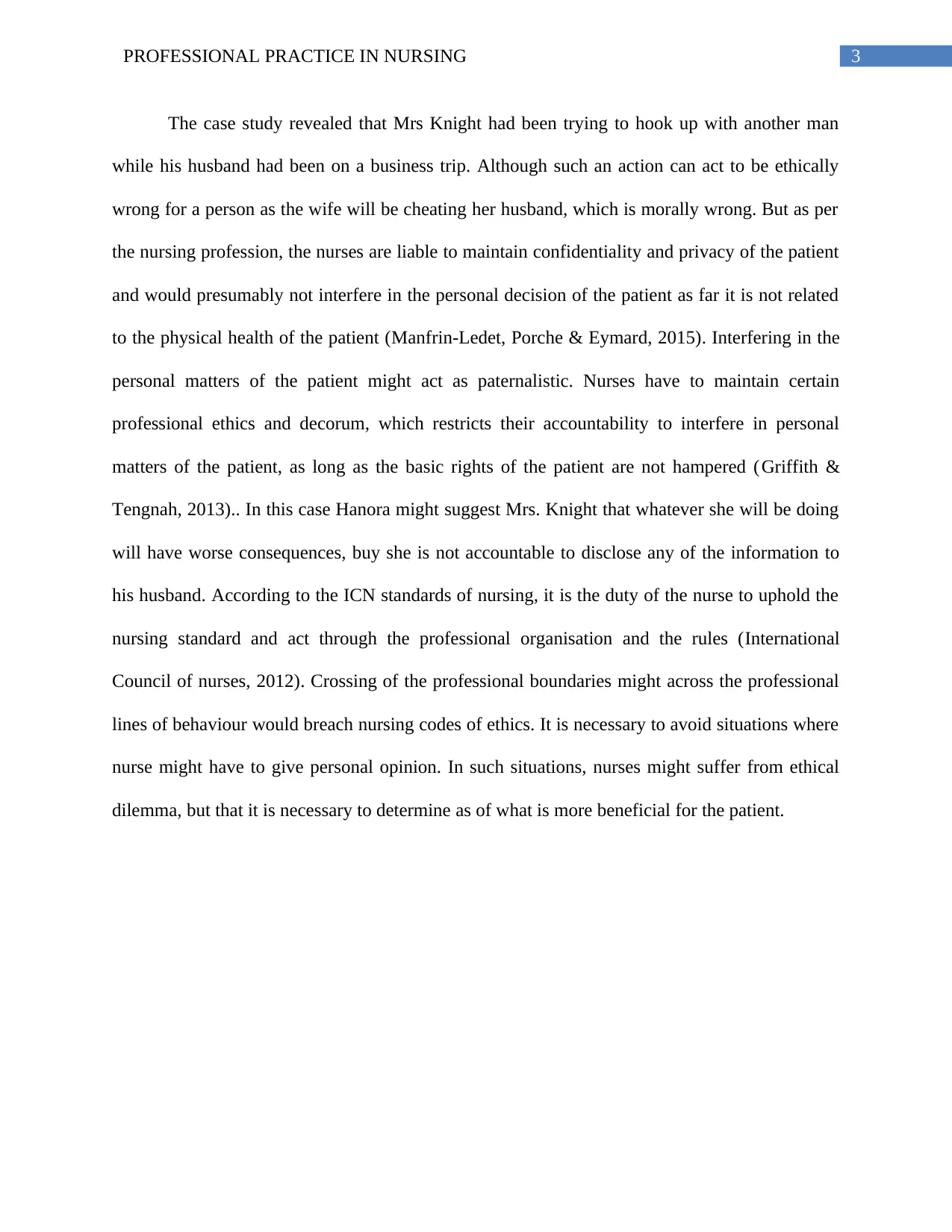
3PROFESSIONAL PRACTICE IN NURSING
The case study revealed that Mrs Knight had been trying to hook up with another man
while his husband had been on a business trip. Although such an action can act to be ethically
wrong for a person as the wife will be cheating her husband, which is morally wrong. But as per
the nursing profession, the nurses are liable to maintain confidentiality and privacy of the patient
and would presumably not interfere in the personal decision of the patient as far it is not related
to the physical health of the patient (Manfrin-Ledet, Porche & Eymard, 2015). Interfering in the
personal matters of the patient might act as paternalistic. Nurses have to maintain certain
professional ethics and decorum, which restricts their accountability to interfere in personal
matters of the patient, as long as the basic rights of the patient are not hampered (Griffith &
Tengnah, 2013).. In this case Hanora might suggest Mrs. Knight that whatever she will be doing
will have worse consequences, buy she is not accountable to disclose any of the information to
his husband. According to the ICN standards of nursing, it is the duty of the nurse to uphold the
nursing standard and act through the professional organisation and the rules (International
Council of nurses, 2012). Crossing of the professional boundaries might across the professional
lines of behaviour would breach nursing codes of ethics. It is necessary to avoid situations where
nurse might have to give personal opinion. In such situations, nurses might suffer from ethical
dilemma, but that it is necessary to determine as of what is more beneficial for the patient.
The case study revealed that Mrs Knight had been trying to hook up with another man
while his husband had been on a business trip. Although such an action can act to be ethically
wrong for a person as the wife will be cheating her husband, which is morally wrong. But as per
the nursing profession, the nurses are liable to maintain confidentiality and privacy of the patient
and would presumably not interfere in the personal decision of the patient as far it is not related
to the physical health of the patient (Manfrin-Ledet, Porche & Eymard, 2015). Interfering in the
personal matters of the patient might act as paternalistic. Nurses have to maintain certain
professional ethics and decorum, which restricts their accountability to interfere in personal
matters of the patient, as long as the basic rights of the patient are not hampered (Griffith &
Tengnah, 2013).. In this case Hanora might suggest Mrs. Knight that whatever she will be doing
will have worse consequences, buy she is not accountable to disclose any of the information to
his husband. According to the ICN standards of nursing, it is the duty of the nurse to uphold the
nursing standard and act through the professional organisation and the rules (International
Council of nurses, 2012). Crossing of the professional boundaries might across the professional
lines of behaviour would breach nursing codes of ethics. It is necessary to avoid situations where
nurse might have to give personal opinion. In such situations, nurses might suffer from ethical
dilemma, but that it is necessary to determine as of what is more beneficial for the patient.
Paraphrase This Document
Need a fresh take? Get an instant paraphrase of this document with our AI Paraphraser
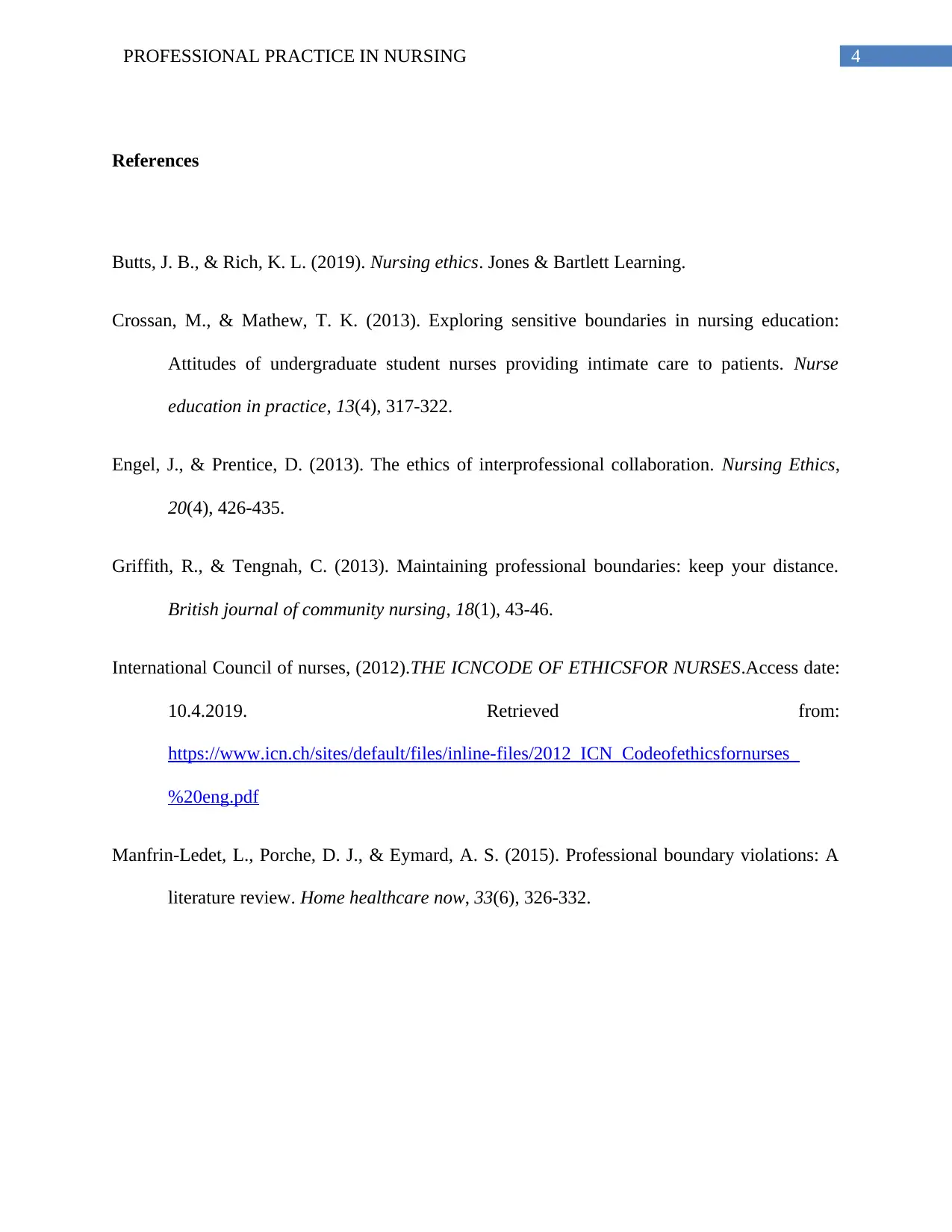
4PROFESSIONAL PRACTICE IN NURSING
References
Butts, J. B., & Rich, K. L. (2019). Nursing ethics. Jones & Bartlett Learning.
Crossan, M., & Mathew, T. K. (2013). Exploring sensitive boundaries in nursing education:
Attitudes of undergraduate student nurses providing intimate care to patients. Nurse
education in practice, 13(4), 317-322.
Engel, J., & Prentice, D. (2013). The ethics of interprofessional collaboration. Nursing Ethics,
20(4), 426-435.
Griffith, R., & Tengnah, C. (2013). Maintaining professional boundaries: keep your distance.
British journal of community nursing, 18(1), 43-46.
International Council of nurses, (2012).THE ICNCODE OF ETHICSFOR NURSES.Access date:
10.4.2019. Retrieved from:
https://www.icn.ch/sites/default/files/inline-files/2012_ICN_Codeofethicsfornurses_
%20eng.pdf
Manfrin-Ledet, L., Porche, D. J., & Eymard, A. S. (2015). Professional boundary violations: A
literature review. Home healthcare now, 33(6), 326-332.
References
Butts, J. B., & Rich, K. L. (2019). Nursing ethics. Jones & Bartlett Learning.
Crossan, M., & Mathew, T. K. (2013). Exploring sensitive boundaries in nursing education:
Attitudes of undergraduate student nurses providing intimate care to patients. Nurse
education in practice, 13(4), 317-322.
Engel, J., & Prentice, D. (2013). The ethics of interprofessional collaboration. Nursing Ethics,
20(4), 426-435.
Griffith, R., & Tengnah, C. (2013). Maintaining professional boundaries: keep your distance.
British journal of community nursing, 18(1), 43-46.
International Council of nurses, (2012).THE ICNCODE OF ETHICSFOR NURSES.Access date:
10.4.2019. Retrieved from:
https://www.icn.ch/sites/default/files/inline-files/2012_ICN_Codeofethicsfornurses_
%20eng.pdf
Manfrin-Ledet, L., Porche, D. J., & Eymard, A. S. (2015). Professional boundary violations: A
literature review. Home healthcare now, 33(6), 326-332.
1 out of 5
Related Documents
Your All-in-One AI-Powered Toolkit for Academic Success.
+13062052269
info@desklib.com
Available 24*7 on WhatsApp / Email
![[object Object]](/_next/static/media/star-bottom.7253800d.svg)
Unlock your academic potential
Copyright © 2020–2025 A2Z Services. All Rights Reserved. Developed and managed by ZUCOL.




